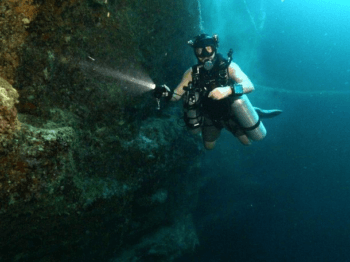Texas A&M-Galveston Prof Featured In National Geographic Special Dec. 7

The mysteries of the Bermuda Triangle and what lies beneath it will be the subject of a National Geographic special on Dec. 7, and the cave diving research of a Texas A&M University at Galveston professor will play a key role in the broadcast.
Tom Iliffe, professor of marine biology and one of the world’s foremost cave divers, will be featured in the program, titled “Drain the Bermuda Triangle” that will air on Sunday (Dec. 7) at 8 p.m. Central on the National Geographic Channel.
The special is one in a series that shows what certain areas of Earth might look like if there were no water above them and what secrets they may hide.
The Bermuda Triangle is one of the most mysterious places on the planet and covers about 500,000 square miles. It’s estimated that around the island of Bermuda alone at least 300 vessels have been lost, many under strange circumstances. The high number of shipwrecks around Bermuda has given the island the nickname of “Isle of Devils.”
Using sonar mapping, scientists such as Iliffe have obtained high-resolution maps of the terrain surrounding Bermuda, which is 650 miles off the eastern U.S. coast. The technology allows the area to be “drained” as deep as three miles down to reveal a vast sea floor known as abyssal plains.
Bermuda and the Bahamas, both in the Bermuda Triangle, are also home to numerous underwater caves called blue holes, so called because from above they resemble a circular clear blue abyss. Iliffe is one of the world’s leading blue hole cave experts and has made hundreds of dives in blue holes within the Bermuda Triangle.
It’s been known for decades that Bermuda sits atop a dead underwater volcanic seamount that formed the island in a series of eruptions some 30 million years ago.

“There are lots of stories about blue holes and folk legends pertaining to them,” Iliffe explains.
“One of them is that there’s a monster called the Luska that lives down in a blue hole and the tidal exchange of water in and out of the cave is actually the Luska monster, inhaling and exhaling.”
Within the Bermuda Triangle, islands are surrounded by treacherous reefs known as breakers that act as natural barriers protecting the islands from hurricanes, but moreover creating a menace to passing ships. This area is also home to rogue waves, large bursts of spontaneous ocean waves that occur in deep waters and can reach as high as 90 feet.
Iliffe has explored more than 1,500 underwater caves, the most of anyone in the world, and along the way he has found time to discover more than 300 forms of marine life, seven of which have been named for him.
Last year, he led a team of nine other divers who descended 462 feet into Phantom Springs Cave in West Texas, making it the deepest underwater cave in the United States. His work has drawn media attention from around the world and been featured on such outlets as The National Geographic Channel, The Discovery Channel and others.
For more information about Iliffe’s research, see his webpage at www.cavebiology.com.
Media contact: Keith Randall, Texas A&M News & Information Services.





